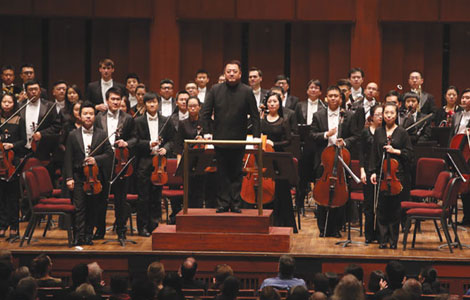Anti-drone weapon passes its shooting test
Updated: 2014-11-04 07:24
By Zhao Lei(China Daily)
|
||||||||
Laser system can find and downunmanned aircraft at low altitudes
China has successfully tested a nationally developed laser defense system that targets low-flying small drones.
The Low Altitude Sentinel system can shoot down small aircraft within a 2-km radius within five seconds of detecting its target, according to a statement from the China Academy of Engineering Physics, one of the system's co-developers.
Characterized by its speed, precision and low noise, the system is designed to destroy small unmanned drones flying within an altitude of 500 meters and at a speed below 180 km/h, the academy said.
Wu Peixin, an aviation industry observer in Beijing, said the system was developed at the right time as the Chinese military had been looking for a weapon to close the defense gaps in the detection and destruction of small drones.
"It is difficult for the radar of Chinese and foreign militaries to track drones flying slowly at low altitude," he said. "The photoelectric laser apparatus can complement radar."
No foreign military has weapons that can effectively detect and defend small, low-altitude drones, so the Low Altitude Sentinel will be a major achievement in the nation's efforts to strengthen its air defense, Wu added.
Yi Jinsong, a manager at China Jiuyuan Hi-Tech Equipment Corp, a group under the academy spearheading the project, lauded the advantages of the new system. "Intercepting small drones has usually been the work of snipers and helicopters, but their success rate is not as high, and mistakes with accuracy can result in unwanted damage," he said.
Yi said that such drones are relatively cheap and easy to use, which makes them a weapon of choice for both battlefield enemies and terrorists.
The Low Altitude Sentinel system, which will either be installed or transported in vehicles, is expected to play a key role in ensuring security during major events in urban areas, the academy said, adding that a recent test saw the machine successfully shoot down more than 30 drones - a 100 percent success rate.
The academy said that its researchers are developing similar laser systems with greater power and range.
Wu suggested that such systems combine lightweight anti-air missiles and quick-firing guns, and the carrying vehicle must have good mobility so the whole system can respond promptly to incoming targets.
Because unmanned combat aerial vehicles have been widely used in field operations, militaries around the world have been striving to find ways to defend against drones, especially those flying at low altitude and low speed.
The Republic of Korea has decided to buy 10 Israeli-made RPS-42 Tactical Air Surveillance Radar Systems to help detect and intercept drones from the Democratic People's Republic of Korea, which has reportedly used unmanned aircraft in several reconnaissance operations over the ROK, according to the Yonhap News Agency.
The US army is also working with defense technology companies on the development of an affordable Counter Unmanned Aerial System, earlier reports said.
Xinhua contributed to this story.
zhaolei@chinadaily.com.cn

 Clean Yanqi Lake for APEC
Clean Yanqi Lake for APEC
 WTC reopens with six-floor China Center
WTC reopens with six-floor China Center
 John Kerry speaks about US-China relations
John Kerry speaks about US-China relations
 China orchestra plays in Washington
China orchestra plays in Washington
 Top 5 sectors that will ride on top of 'through train'
Top 5 sectors that will ride on top of 'through train'
 Forum Trends: Should students study abroad?
Forum Trends: Should students study abroad?
 Hong Kong films to take center stage
Hong Kong films to take center stage
 Healing through art at UN
Healing through art at UN
Most Viewed
Editor's Picks

|

|

|

|

|

|
Today's Top News
Alibaba Q2 revenue surges
Healing through art at UN
China orchestra plays in Washington
Asian American seeks RI governorship
Chinese envoy urges to enhance nuclear safety
US packer opens new plant in China
Mandarin in 6 months?Can it work?
New agency to strengthen graft fightus
US Weekly

|

|







